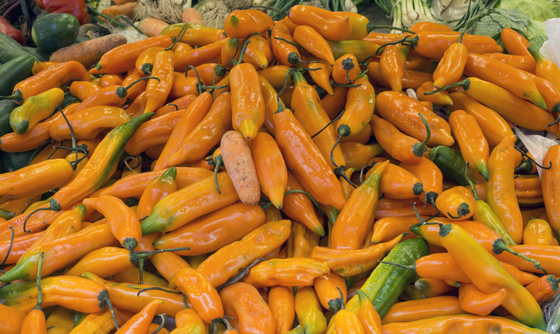Even in the land of Red or Green, sometimes the answer is yellow.
Here, as in most of the United States, we are used to a certain species of chile pepper, Capsicum annuum, which includes our classic New Mexican chiles, along with bell peppers, cayennes, and most other peppers we find (other than habanero and tabasco peppers) at local chile stands, farmers markets, grocery stores, and restaurants. In Peru, however, the Capsicum baccatum reigns, and a pepper called aji amarillo, meaning “yellow pepper,” is one of the most popular. Tio David’s Peruvian Flavor in Albuquerque is one of the few places around where you can find this pepper and, even for the non-chilephiles among us, it’s well worth a taste.
We popped into Tio David’s recently for a bite of the tasty yellow sauce made from this pepper. We also wanted to show support after the recent loss of the restaurant’s namesake and founding chef, David Guillermo Diaz Marini, who will be deeply missed. Tio David had been cooking for his family, friends, and community for half a century, first in Lima, Peru, and then, starting in 2001, in Albuquerque. He brought recipes he had learned over his life to New Mexico, and introduced many diners here to Peruvian flavors. Chef Joe Anguiano, who has worked in kitchens around the globe, including the Michelin-starred Zuberoa in Oiartzun, Spain, was at the helm the night we visited. We had a delicious meal and left more sure than ever that, at Tio David’s at least, yellow remains a very good way to go.
In case you missed it: The Bite is the new sister publication to edible New Mexico. Our first issue hits stands the first week of September. You can update your email preferences using the “Update Profile” link in the footer at the bottom of this email.

Delicious Things
Last weekend, it was our fortune to drink fresh mountain air after a rainstorm. We haven’t been ordained in the secret recipe for this one, but we thought we detected a touch of pine, damp granite, juniper, oak, desert mountain mahogany, something succulent, a dash of sand and lime, and the faintest traces of geosmin. If we had the tech, we’d bottle this and save it for one of those desperately dry summer days—maybe our friends at Dryland Wilds will develop a petrichor hydrosol in honor of the monsoons of 2021. Instead, we’ve been eating things that evoke that airy, fresh, earthy, clean scent of cool relief: an amuse-bouche of cucumbers and basil, tomatoes dressed in adjika (a Georgian relish made from mint and serranos, borrowed from Christopher Kimball’s Milk Street), and purple romano beans—tender enough to eat straight off the vine—dressed in a barely there marinade.
Entrances & Exits
Led by Chef Steve Riley, formerly of Farm & Table, Mesa Provisions opened this week in Albuquerque’s Nob Hill, in the space formerly used by Canvas Artistry. Tip from our sources: go for the sauces.
Rustica, specializing in handmade pastas, opened the same day on Camino Entrada in Santa Fe. In addition to a range of Italian classics, the menu features a Ranch House pizza made with pulled pork—a shoutout to the barbecue restaurant that proprietors Josh Baum and Ann Gordon have run since 2011 on Cristo’s Road.
Looking for a new place to try mutton stew in Albuquerque? The El ROI Cafe opened not too long ago on Sixth and Lomas. They also do blue corn mush and Indian tacos.
Also serving Indian tacos is Pueblo Street Food—which will be setting up at the reopening of Silver Moon Studio, owned by writer/photographer (and The Bite contributor) Ungelbah Dávila-Shivers, on August 14 in Bosque Farms.
Need to amp up your piping skills? Rude Boy Cookies is hosting a cookie-decorating class on August 15.
Distillations
Do you have an apple tree or access to one, and aren’t quite sure what to do with the hail-pocked fruits created by one of the storms that decimated crops on some local farms earlier this year? Cider, pie, preserves, and fresh eating are all great options, but if you’re feeling particularly entrepreneurial, you could always take a page from James Webb Young—an advertising executive who moved to La Cañada de Cochiti in 1927 and planted what would later become known as the Dixon’s Apple Orchard—and market them as extra delicious! In a new book, Fruit, Fiber, and Fire: A History of Modern Agriculture in New Mexico, author (and The Bite co-editor) Willy Carleton explains how Young marketed his apples’ blemishes as badges of mountain-grown quality that actually improved the flavor. He wound up shipping the apples to eager buyers as far as New York, and eventually buyers were even requesting pockmarked apples over non-blemished ones.
Eater recently formed a partnership with the award-winning podcast, Gastropod, which dives into the history and science of food. The latest episode discusses cannabis in food, and the long history of edibles that goes back thousands of years.
Speaking of cannabis, CalMatters reports that illegal pot farms in California have been the biggest culprit in one of the state’s ongoing drought-related problems: water thievery. Meanwhile, the question of whether there is enough water in New Mexico to support cannabis farming is a concerning one for many, as recently reported by the Santa Fe New Mexican.
Our favorite ideas on culinary lavender among those that landed in our inbox last week: fried green tomatoes with lavender béchamel, and squash blossoms stuffed with lavender goat cheese. Thank you for the ideas—and thank you for reading.







